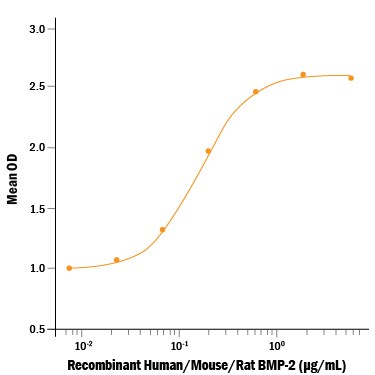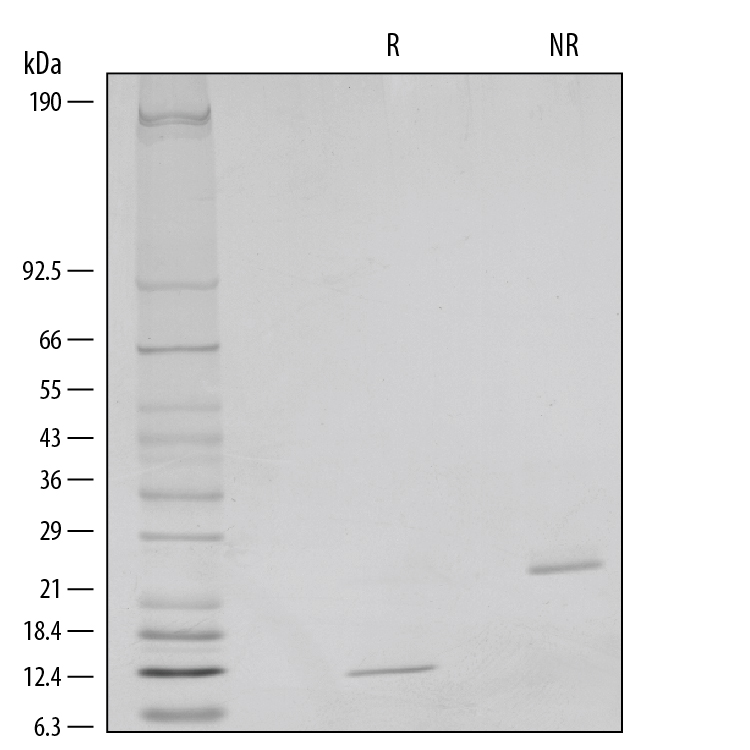Recombinant Human/Mouse/Rat BMP-2 (E. coli-expressed)
Recombinant Human/Mouse/Rat BMP-2 (E. coli-expressed) Summary
Product Specifications
Ala284-Arg396
This form is not detected using human BMP-2 Quantikine ELISA (Catalog # DBP200).
Analysis
Product Datasheets
Carrier Free
CF stands for Carrier Free (CF). We typically add Bovine Serum Albumin (BSA) as a carrier protein to our recombinant proteins. Adding a carrier protein enhances protein stability, increases shelf-life, and allows the recombinant protein to be stored at a more dilute concentration. The carrier free version does not contain BSA.
In general, we advise purchasing the recombinant protein with BSA for use in cell or tissue culture, or as an ELISA standard. In contrast, the carrier free protein is recommended for applications, in which the presence of BSA could interfere.
355-BEC
| Formulation | Lyophilized from a 0.2 μm filtered solution in Acetonitrile and TFA with BSA as a carrier protein. |
| Reconstitution | Reconstitute at 100 μg/mL in sterile 4 mM HCl containing at least 0.1% human or bovine serum albumin. |
| Shipping | The product is shipped at ambient temperature. Upon receipt, store it immediately at the temperature recommended below. |
| Stability & Storage: | Use a manual defrost freezer and avoid repeated freeze-thaw cycles.
|
355-BEC/CF
| Formulation | Lyophilized from a 0.2 μm filtered solution in Acetonitrile and TFA. |
| Reconstitution | Reconstitute at 100 μg/mL in sterile 4 mM HCl. |
| Shipping | The product is shipped at ambient temperature. Upon receipt, store it immediately at the temperature recommended below. |
| Stability & Storage: | Use a manual defrost freezer and avoid repeated freeze-thaw cycles.
|
Scientific Data
 View Larger
View Larger
Recombinant Human/Mouse/Rat BMP-2 (Catalog # 355-BEC/CF) induces alkaline phosphatase production in the ATDC5 mouse chondrogenic cell line. The ED50 for this effect is 0.08-0.48 μg/mL.
 View Larger
View Larger
1 μg/lane of Recombinant Human/Mouse/Rat BMP-2 was resolved with SDS-PAGE under reducing (R) and non-reducing (NR) conditions and visualized by silver staining, showing single bands at 12 kDa and 24 kDa, respectively.
Reconstitution Calculator
Background: BMP-2
Human BMP-2 is one of at least 15 structurally and functionally related BMPs, which are members of the transforming growth factor beta (TGF-beta ) superfamily. BMPs were originally identified as protein regulators of cartilage and bone formation. However, they have since been shown to be involved in embryogenesis and morphogenesis of various tissues and organs. BMPs have also been shown to regulate the growth, differentiation, chemotaxis and apoptosis of various cell types, including mesenchymal cells, epithelial cells, hematopoietic cells and neuronal cells. Similarly to other TGF-beta family proteins, BMPs are highly conserved across animal species. At the amino acid sequence level, mature human, mouse and rat BMP-2 are 100% identical. BMP-2 is synthesized as a large precursor protein that is cleaved at the dibasic cleavage site (RXXR) to release the carboxy-terminal domain. Biologically active BMP-2 is a disulfide-linked homodimer of the carboxy-terminal 114 amino acid residues that contains the characteristic seven conserved cysteine residues involved in the formation of the cysteine knot and the single interchain disulfide bond. Cellular responses to BMP-2 have been shown to be mediated by the formation of hetero-oligomeric complexes of type I and type II serine/threonine kinase receptors. One BMP type II and two BMP type I receptors have been identified. In contrast to the TGF-beta type I receptor, which does not bind the ligand in the absence of the TGF-beta receptor type II, both BMP receptor type Is can bind BMP-2 with high-affinity in the absence of BMP receptor type II.
- Kawabata, M. et al. (1998) Cytokine and Growth Factor Reviews 9:49
- Ebendal, T. et al. (1998) J. Neurosci. Res. 51:139.
- Reddi, A.H. (1998) Nature Biotechnology 16: 247.
Citations for Recombinant Human/Mouse/Rat BMP-2 (E. coli-expressed)
R&D Systems personnel manually curate a database that contains references using R&D Systems products. The data collected includes not only links to publications in PubMed, but also provides information about sample types, species, and experimental conditions.
10
Citations: Showing 1 - 10
Filter your results:
Filter by:
-
GREM2 inactivation increases trabecular bone mass in mice
Authors: Nilsson, KH;Henning, P;Wu, J;Sjögren, K;Lerner, UH;Ohlsson, C;Movérare-Skrtic, S;
Scientific reports
Species: Mouse
Sample Types: Whole Cells
Applications: Bioassay -
Development and Characterization of Alkaline Phosphatase-Positive Human Umbilical Cord Perivascular Cells
Authors: S Nonoyama, T Karakida, R Chiba-Ohku, R Yamamoto, Y Ujiie, T Nagano, Y Yamakoshi, K Gomi
Cells, 2021-11-04;10(11):.
Species: Human
Sample Types: Whole Cells
Applications: Bioassay -
Phorbol-12-myristate 13-acetate inhibits Nephronectin gene expression via Protein kinase C alpha and c-Jun/c-Fos transcription factors
Authors: M Kinoshita, A Yamada, K Sasa, K Ikezaki, T Shirota, R Kamijo
Scientific Reports, 2021-10-13;11(1):20360.
Species: Mouse
Sample Types: Whole Cells
Applications: Bioassay -
Combined Effect of Midazolam and Bone Morphogenetic Protein-2 for Differentiation Induction from C2C12 Myoblast Cells to Osteoblasts
Authors: Y Hidaka, R Chiba-Ohku, T Karakida, K Onuma, R Yamamoto, K Fujii-Abe, MM Saito, Y Yamakoshi, H Kawahara
Pharmaceutics, 2020-03-02;12(3):.
Species: Mouse
Sample Types: Whole Cells
Applications: Cell Culture -
Vitamin D-regulated osteocytic sclerostin and BMP2 modulate uremic extraskeletal calcification
Authors: L Nguyen-Yam, KI Tanaka, R St-Arnaud, D Goltzman
JCI Insight, 2019-07-11;4(13):.
Species: Rat
Sample Types: Whole Cells
Applications: Bioassay -
Notch regulates BMP responsiveness and lateral branching in vessel networks via SMAD6
Nat Commun, 2016-11-11;7(0):13247.
Species: Mouse
Sample Types: Whole Cells
Applications: Bioassay -
Quantitative Proteomics of the SMAD (Suppressor of Mothers against Decapentaplegic) Transcription Factor Family Identifies Importin 5 as a Bone Morphogenic Protein Receptor SMAD-specific Importin
Authors: H Th Marc Timme
J. Biol. Chem., 2016-10-04;291(46):24121-24132.
Species: Human
Sample Types: Whole Cells
Applications: Bioassay -
Canine epidermal neural crest stem cells: characterization and potential as therapy candidate for a large animal model of spinal cord injury.
Authors: Gericota B, Anderson J, Mitchell G, Borjesson D, Sturges B, Nolta J, Sieber-Blum M
Stem Cells Transl Med, 2014-01-17;3(3):334-45.
Species: Canine
Sample Types: Whole Cells
Applications: Bioassay -
A rapid and sensitive bioassay for the simultaneous measurement of multiple bone morphogenetic proteins. Identification and quantification of BMP4, BMP6 and BMP9 in bovine and human serum.
Authors: Herrera B, Inman GJ
BMC Cell Biol., 2009-03-19;10(0):20.
Species: Mouse
Sample Types: Whole Cells
Applications: Bioassay -
Iron transferrin regulates hepcidin synthesis in primary hepatocyte culture through hemojuvelin and BMP2/4.
Authors: Lin L, Valore EV, Nemeth E, Goodnough JB, Gabayan V, Ganz T
Blood, 2007-05-31;110(6):2182-9.
Species: Mouse
Sample Types: Whole Cells
Applications: Bioassay
FAQs
-
What is the difference between the two Recombinant Human/Mouse/Rat BMP-2 Proteins (Catalog # 355-BM and 355-BEC)?
Catalog # 355-BM is produced in a mammalian system using CHO cells and exhibits better activity in our routine QC bioassay, while Catalog # 355-BEC is produced in an E. coli expression system and is less expensive. Bioactivity of both Human/Mouse/Rat BMP-2 Proteins is measured in an alkaline phosphatase assay using by ATDC5 mouse chondrogenic cells. For 355-BM, the ED50 for this effect is 40-200 ng/mL, while for 355-BEC, the ED50 range is 80-480 ng/mL. We recommend reviewing our list of publications under the Citations tab for both 355-BM and 355-BEC to determine which of the two proteins is most suitable for your experiment.
-
What is the sequence homology between human, mouse and rat BMP-2
Mature human BMP-2 shares 100% aa sequence identity with mouse and rat BMP-2.
Reviews for Recombinant Human/Mouse/Rat BMP-2 (E. coli-expressed)
There are currently no reviews for this product. Be the first to review Recombinant Human/Mouse/Rat BMP-2 (E. coli-expressed) and earn rewards!
Have you used Recombinant Human/Mouse/Rat BMP-2 (E. coli-expressed)?
Submit a review and receive an Amazon gift card.
$25/€18/£15/$25CAN/¥75 Yuan/¥2500 Yen for a review with an image
$10/€7/£6/$10 CAD/¥70 Yuan/¥1110 Yen for a review without an image


